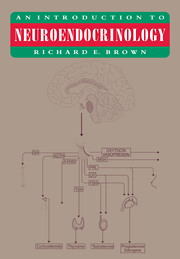Book contents
- Frontmatter
- Contents
- Preface
- Acknowledgements
- Illustration credits
- List of abbreviations
- 1 Classification of chemical messengers
- 2 The endocrine glands and their hormones
- 3 The pituitary gland and its hormones
- 4 The hypothalamic hormones
- 5 Neurotransmitters
- 6 Neurotransmitter control of hypothalamic, pituitary and other hormones
- 7 Regulation of hormone synthesis, storage, release, transport and deactivation
- 8 Regulation of hormone levels in the bloodstream
- 9 Steroid and thyroid hormone receptors
- 10 Receptors for peptide hormones, neuropeptides and neurotransmitters
- 11 Neuropeptides I: classification, synthesis and colocalization with classical neurotransmitters
- 12 Neuropeptides II: neuropeptide function
- 13 Cytokines and the interaction between the neuroendocrine and immune systems
- 14 Methods for the study of behavioral neuroendocrinology
- 15 An overview of behavioral neuroendocrinology: present, future and past
- Appendix Journals in endocrinology, neuroendocrinology, psychoneuroimmunology and behavioral endocrinology
- Index
15 - An overview of behavioral neuroendocrinology: present, future and past
Published online by Cambridge University Press: 26 December 2009
- Frontmatter
- Contents
- Preface
- Acknowledgements
- Illustration credits
- List of abbreviations
- 1 Classification of chemical messengers
- 2 The endocrine glands and their hormones
- 3 The pituitary gland and its hormones
- 4 The hypothalamic hormones
- 5 Neurotransmitters
- 6 Neurotransmitter control of hypothalamic, pituitary and other hormones
- 7 Regulation of hormone synthesis, storage, release, transport and deactivation
- 8 Regulation of hormone levels in the bloodstream
- 9 Steroid and thyroid hormone receptors
- 10 Receptors for peptide hormones, neuropeptides and neurotransmitters
- 11 Neuropeptides I: classification, synthesis and colocalization with classical neurotransmitters
- 12 Neuropeptides II: neuropeptide function
- 13 Cytokines and the interaction between the neuroendocrine and immune systems
- 14 Methods for the study of behavioral neuroendocrinology
- 15 An overview of behavioral neuroendocrinology: present, future and past
- Appendix Journals in endocrinology, neuroendocrinology, psychoneuroimmunology and behavioral endocrinology
- Index
Summary
THE AIM OF THIS BOOK
The aim of this book is to teach students the language and concepts of neuroendocrinology with an emphasis on how the neuroendocrine system influences behavior. It began with a classification of chemical messengers in the body as ‘true’ hormones, neurohormones, neurotransmitters, pheromones, parahormones, prohormones, growth factors and neuroregulators. As more became known about the neuroendocrine system, it was seen that these classifications are not clear cut and a single chemical could fit into two or more classes of messenger. While the classification of chemical messengers is useful to begin the study of neuroendocrinology, by the end it provides little help in understanding the different actions of peptides, steroids and neurotransmitters on different target cells.
The endocrine glands and the pituitary gland are generally thought to be the basis of the neuroendocrine system, but the traditional endocrine function of hormones acting on peripheral target cells provides only a small part of the neuroendocrine activity of a hormone such as testosterone, cholecystokinin or prolactin. These hormones also have significant effects on neural receptors and alter neural regulation of autonomic reflexes, behavior and emotional states. The hypothalamus provides the link between the traditional endocrine system and the brain and provides the mechanism for external factors to regulate the endocrine system. Thus, while the endocrine system appears to consist of a number of closed-loop feedback systems, with highly regulated physiological control over the synthesis, storage, release and deactivation of hormones, external stimuli can alter these systems. Environmental stimuli, social interactions and cognitive factors can greatly alter the functioning of the endocrine system by altering the ‘classical’ neurotransmitter pathways which regulate the release of hypothalamic hormones.
- Type
- Chapter
- Information
- An Introduction to Neuroendocrinology , pp. 395 - 399Publisher: Cambridge University PressPrint publication year: 1994



